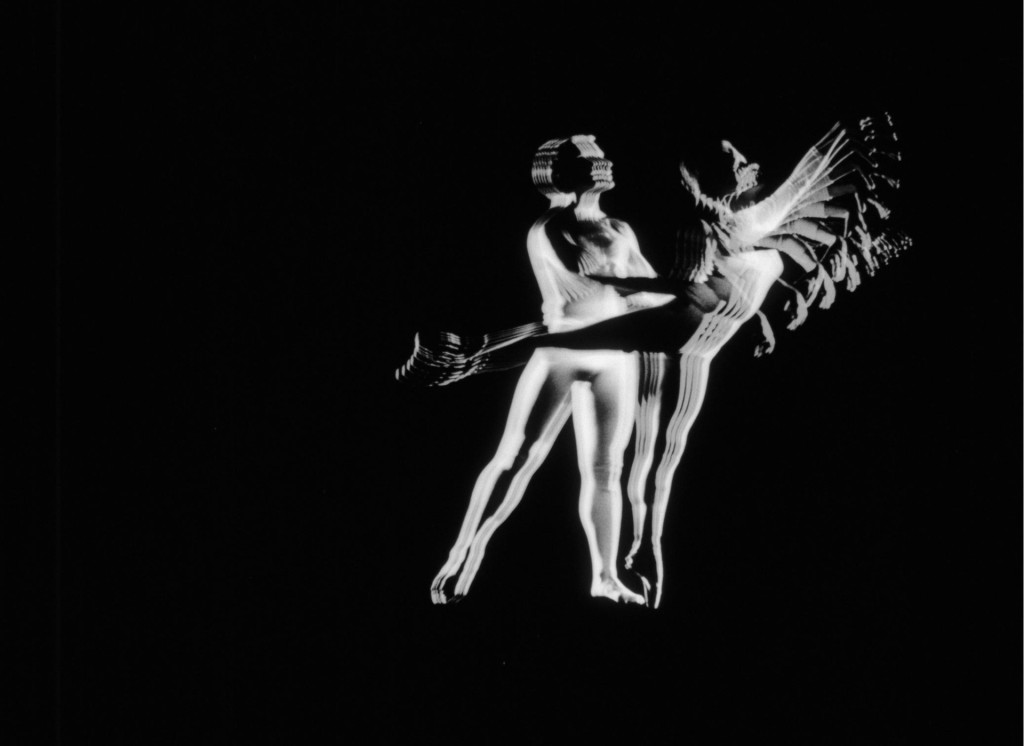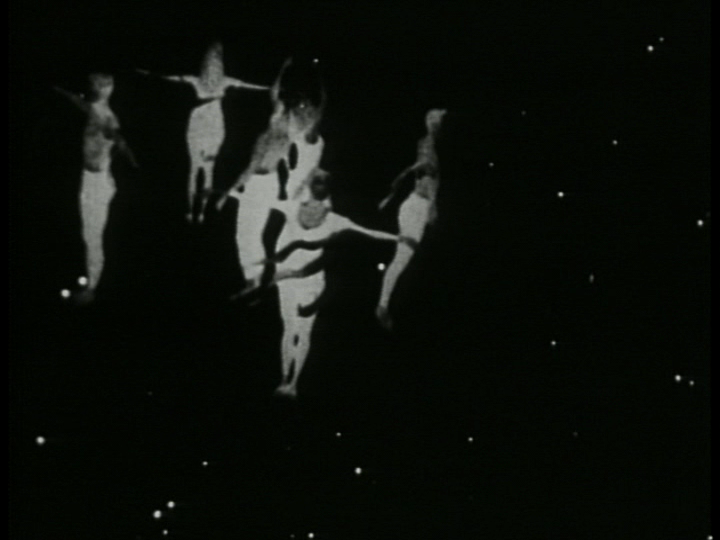Beyond a pure fascination with the emotional and physical range of ballet, something in the endless vacuum of space beckoned experimental filmmakers Maya Deren and Norman McLaren to produce shorts of similarly stunning visual contrast in b/w. Whether it was Deren’s initially radical emphasis on ritualistic performance that culminated in one of her final collaborative masterpieces, The Very Eye of Night (1958), or McLaren’s pioneering regard for animation throughout his career that was focused into the stroboscopic duet, Pas de Deux (1968), the two envisioned an ideal cinematic canvas for the art of movement, daring the mortal body to escape its form, defy gravity, and become celestial.
Perhaps their uncanny juxtapositions can only be adequately articulated through a comparably creative experiment of body and mind with the interplay of light and shadow. As the Scottish-Canadian McLaren descended from the Ukrainian-American Deren, there would seem to be a renascent inspiration across the globe beneath alignment of the stars, the very ones witnessed each summer above the avant-garde showcases at Madison Museum of Contemporary Art’s Rooftop Cinema curated by Tom Yoshikami and projected by Mike King.

Premiering in June 2011’s Rooftop Cinema programming, Pas de Deux initiated the retrospective under the thematic “Powers of Light and Space” last Friday, June 12. From negative space, the sudden grace of the lone ballerina, Margaret Mercier, is announced with an illuminating ambient drone and cascading harp (courtesy of the United Folk Orchestra of Romania) as she arises to unveil her form. Choreographed by Ludmilla Chiriaeff, Mercier’s gradual ascension to the foreground is augmented by the simultaneous presence of whispering panpipes and optical mirroring (through step-and-repeat printing) of the dancer’s acrobatic routine where her poses are prefigured through still-photographs overlaid onto the celluloid.
As if her romantic movement produces an audible call, the ballerino, Vincent Warren, emerges from the left-hand corner of the frame to reciprocate. The two engage in the titular duet where the hypnotic effect magnifies exponentially in step. No longer bound to their physical dimensions, figures blossom into an evolving and unbroken tapestry of flora, swans, and finally, angelic creatures with a sudden swooping of the arms. Collectively, Chiriaeff, Mercier, Warren, and McLaren sensuously and wordlessly convey the complexity of a relationship (suspended in space and time) in a mere thirteen minutes. And yet, hidden within its cosmic frames is homage to one of the most magnificent foremothers of the avant-garde, Maya Deren.

While she is oft-recognized for her recurring fever dream-puzzle, Meshes of the Afternoon (1943), Deren’s equally evocative later work focused almost exclusively on the rhythms of dance. A decade before McLaren’s own dreamlike affair, she was putting the finishing touches on an operatic piece (“a choreography for camera”) featuring the Metropolitan Ballet School under the tutelage of Anthony Tudor. The Very Eye of Night is a concentrated personification of the constellations in the solar-lunar system in an Eastern aesthetic; as two apparitional figures in photo negative float into frame, they oscillate with the ringing modal scales of Teiji Ito (Deren’s partner and frequent collaborator)’s Indonesian metallophone.
Much like Pas de Deux, The Very Eye of Night‘s choreography becomes a celebration of communal transcendence; instead of a pair’s intertwining mirror-motions, the illusion of weightlessness informs the complex galaxial glimpse of the revolving orientations of a troupe of performers. As McLaren’s dancers are visually transformed by their patterned after-effects of agile extensions and contortions, the cast in Deren’s work are costumed to embody Gemini, Ariel, Oberon, Umbriel, Titania, Uranus, Urania, and Noctambulo in the night sky with their movements mimicking symbolic attributes of these eternal bodies. The dancers’ frames hold pose, fall at camera close-up, and reassemble, demonstrating the coexistence of mortal fragility and spiritual resilience. Deren’s illustriously introspective ballet is a journey as heavenly and mystifying as it is earthly and intimate.
As a yin-yang is contained within the iris of The Very Eye of Night‘s title card, the film predicts the unification of coexisting energies not only within itself but within the art of dance and its translation and manipulation in the cinematic medium through the second half of the twentieth century. Both it and Pas de Deux, each of quarter-hour duration, condense and collide the inspirations of dance and film with astral visions and emotional rhythms both personal and mythological. Deren and McLaren ultimately pushed their art onto literally higher planes and inspired a new generation of filmmakers to experiment with human movement, several of whom may be witnessed in future Rooftop Cinema programs.
- Rooftop Cinema is celebrating a decade of screening alternative and avant-garde short films all summer at the Madison Museum of Contemporary Art.

